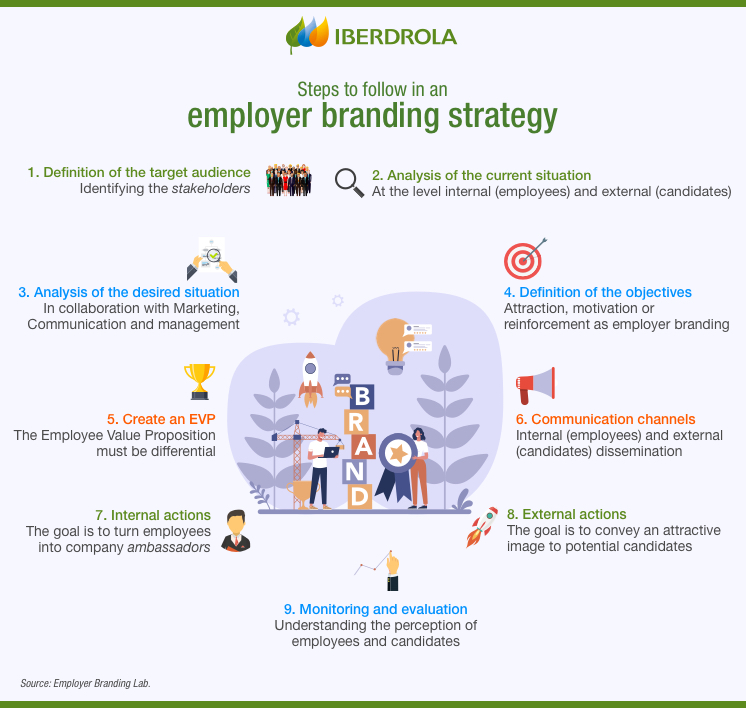Employer branding
Employer branding, a key technique for talent attraction and retention
Talent is a differential value for companies on their path to success. As a result, companies are devoting ever increasing time and resources to enhancing their reputation and value proposition towards employees. The aim is to capture, attract and retain talent, as well as to increase engagement. Below, we review the main strategies for building human capital loyalty.

Talent is currently the asset most highly prized by companies, as it is the key to achieving success. In the last two decades, the term has gone from being almost exclusively associated with the arts and sciences to being the most sought-after commodity in the business world. Why? The answer probably lies in the current context of the digital transformation that is changing so rapidly that talent becomes the constant that makes the difference.
What is employer branding. Goals and objectives
Employer branding mainly refers to a company's reputation, that is, to the image it projects towards its own employees and potential candidates for vacant positions, which translates into a greater loyalty from the former and a fervent desire by the latter to work for the company. Therefore, the main objective is to build a positioning that allows the best professional profiles to be attracted and retained.
Even though the term was coined in 1996 by two British professors, Simon Barrow and Tim Ambler, it was in the second decade of the 21st century when its use became more widespread in the business world as an essential strategy in Human Resources, although it also requires the involvement of other departments such as Marketing and Communication.
The main advantages of employer branding include: an increase in the number of candidates interested in joining the workforce; improved employee loyalty, minimizing absenteeism and staff turnover; a 46 % reduction in recruitment costs and a 10 % reduction in staff costs, according to data from Randstad; reinforcement the sense of belonging of human capital and thus the motivation and involvement, differentiation itself from the competition based on its value-added proposition and it boosts the company's brand image in society, etc.
Talent retention. Employer branding strategies
According to a study by the Robert Walters Group, a British professional recruitment group, there are three fundamental ways to capture and retain talent, especially among millennials who have just joined the working world: a career plan, a competitive salary and the use of technology. The French multinational Sodexo, with around 380,000 employees, adds others factors such as flexibility, continuous training and a good atmosphere.
For Human Resources experts, talent is a strategic asset within the corporate culture and, therefore, a number of human capital methods come into play here, the most common of which include:
 Fostering a good working environment
Fostering a good working environment
The key is to both retain employees, who, in turn, can act as ambassadors for the company, and to attract candidates, as work climate surveys provide an insight into the internal reality within companies.
 Define reward schemes
Define reward schemes
Every employee has their own personality, but recognition from the company is part of the so-called emotional salary and helps to boost their well-being, motivate them and ensure their loyalty.
 Offer continuous training
Offer continuous training
Employees and candidates are looking for professional growth and self-improvement, so it is essential to give them the opportunity to learn constantly by providing them with courses and by catering to their interests.
 Establish smooth communication
Establish smooth communication
Companies must communicate at all levels and in all directions — horizontally, vertically and transversally — and give employees the opportunity to contribute their point of view, so that they feel heard.
 Develop career plans
Develop career plans
Guiding professionals towards finding their purpose in the workplace, through practices such as mentoring or coaching, and enabling them to move into leadership positions are very important resources for retaining talent.

Examples of employer branding
A full 62 % of companies consider employer branding to be a priority, according to the 2020 Outlook study: The Future Of Employer Branding produced by Universum from a survey of 2,500 professionals from 18 countries. And this is because it has an impact on a company's results, according to the report: The Secret Sauce of Top Companies: Aligning Your Consumer Brand and Your Talent Brand, from Linkedin and Lippincott. It states that the value of the shares of the companies studied skyrocketed 36 % with the right strategy.
This is the reason large companies have successfully developed employer branding strategies. One of the main ones is Google, which is why we will review the keys that have made it such an attractive company:
- It takes care of its external image by conveying innovation, and it defines and practices its corporate values and actively listens to its community.
- It cares about its workers internally, establishing good wages and other social benefits (social security, legal service, etc.). In addition, they are committed to flexibility, offering the option of teleworking and their facilities include free food, leisure and relaxation areas, etc.
- Their selection processes are not so much based on CVs as on the soft skills of the candidates: emotional intelligence, critical thinking, creativity, etc.
- They are an outstanding company in the training and education of their employees, as well as in the promotion and development of intrapreneurs.
- It encourages active internal communication and a positive work environment by having involved leaders who are highly valued by the workforce.
Another example is Netflix: the balance between responsibility and freedom that the company offers its employees makes it tremendously attractive to talent, and also allows it to retain highly qualified professionals. Cisco, for its part, bases its strategy on trust and commitment, putting into practice three key elements: flexible working allowing employees to choose when and where they work; talent identification through various programmes; and promoting diversity.





